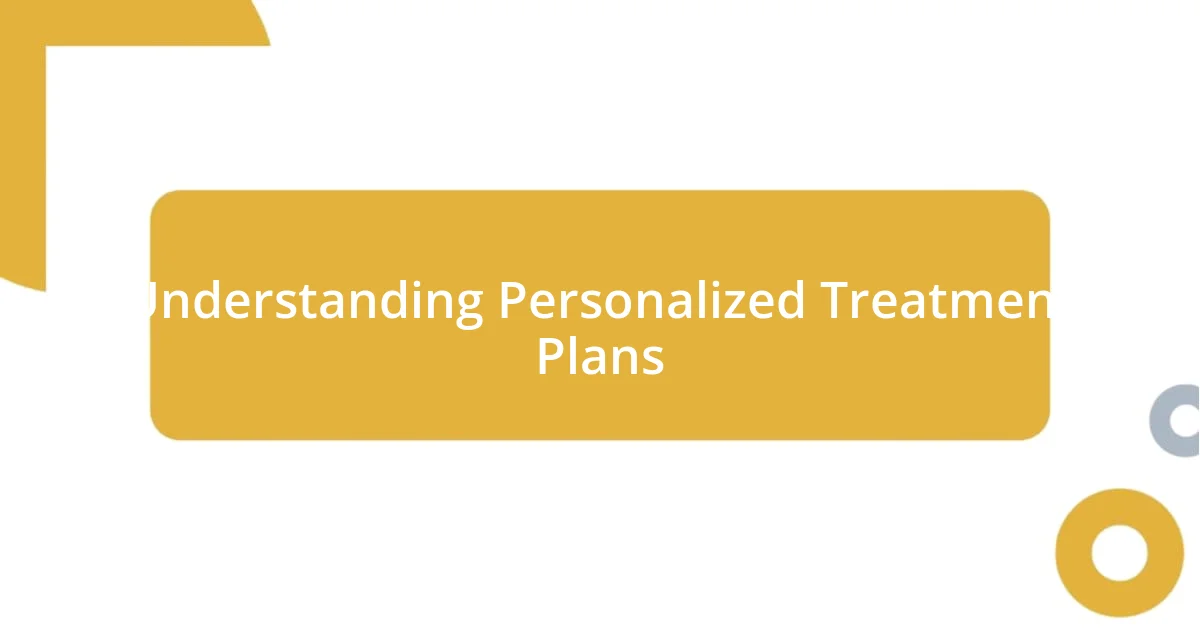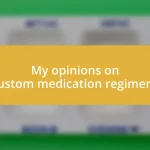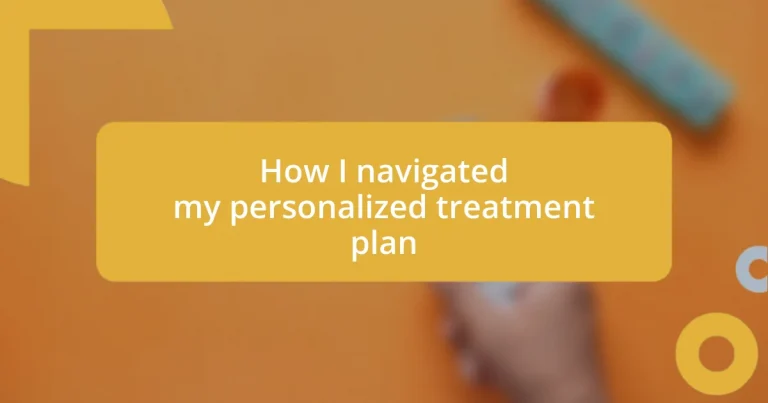Key takeaways:
- Personalized treatment plans allow for ongoing adjustments based on individual feedback, ensuring that care is tailored to each patient’s unique needs.
- Open communication with healthcare professionals is essential; discussing emotions and treatment frustrations fosters a collaborative approach to healing.
- Reflecting on the journey, including challenges and small victories, reinforces the importance of patience and self-advocacy in one’s health narrative.

Understanding Personalized Treatment Plans
A personalized treatment plan is like a roadmap designed specifically for your health journey. I remember when my doctor sat down with me, asking detailed questions not just about my symptoms but also about my lifestyle and preferences. It felt reassuring to know that my treatment was crafted with my unique needs in mind, leading me to wonder—how many others are truly engaged in such tailored approaches?
The beauty of personalized treatment plans lies in their ability to adapt over time. When I faced side effects from my initial medication, my healthcare team quickly reassessed my plan, working collaboratively to find alternatives. This proactive method not only made me feel heard but also empowered me to take an active role in my recovery. Have you ever considered how crucial it is for your health professionals to listen and adjust based on your feedback?
Moreover, understanding that your body is different from anyone else’s can fundamentally change your treatment experience. Embracing the individuality of your health means that what works for one person might not work for another. Personally, this realization transformed my outlook; it reminded me that while some treatments are evidence-based, the best results often come from a blend of science and personal experience.

Assessing My Health Needs
When I first started assessing my health needs, I felt a mix of excitement and anxiety. It wasn’t just about understanding my physical health—it was about delving deep into my emotional and mental well-being as well. I vividly recall answering a series of questions from my healthcare provider; some were straightforward about symptoms, but others really made me reflect on my daily routines and stress levels. This comprehensive evaluation helped me identify not just what I wanted to tackle but also what I truly needed for my overall wellness.
An important part of this process was recognizing the unique aspects of my lifestyle that influenced my health. I had to consider factors like my sleep patterns and dietary habits that I previously took for granted. For instance, I discovered that my late-night snacking was more of a comfort activity rather than genuine hunger—a detail I hadn’t fully acknowledged until it was pointed out. This self-awareness was a game changer, informing my treatment plan in a way that felt practical and realistic to my everyday life.
As I progressed in this evaluation stage, I noticed that my feelings about my health fluctuated. Some days, I felt empowered, while others were tinged with frustration. Through it all, I learned that openly discussing these emotions with my healthcare team made a huge difference. It was therapeutic, almost like moving from a fog to clarity, where every conversation was a step toward a more tailored health strategy reflecting my true needs.
| Assessment Element | Reflection |
|---|---|
| Physical Symptoms | Identified specific issues like fatigue and pain. |
| Lifestyle Factors | Explored eating habits, activity levels, and sleep patterns. |
| Emotional Health | Discussed the impact of stress and anxiety on my overall health. |

Identifying Treatment Options
Identifying treatment options is a crucial step in creating an effective personalized treatment plan. I remember sitting with my healthcare team, pouring over various treatment possibilities. They opened my eyes to choices I had never considered, from lifestyle changes to alternative therapies. It felt liberating to explore these different avenues, knowing I had a say in my journey.
Here are some treatment options we discussed during my evaluation:
- Medications: Various prescriptions targeting different symptoms.
- Therapies: Options like physical therapy, cognitive-behavioral therapy, or acupuncture.
- Lifestyle Changes: Nutrition, exercise, and stress management techniques.
- Support Groups: Connecting with others who share similar experiences for emotional support.
- Alternative Treatments: Exploring holistic approaches like herbal remedies or mindfulness practices.
Sometimes, the process felt overwhelming. I often wondered whether I was making the right choices. The key, I realized, was to actively engage in discussions with my healthcare providers. Their expertise, combined with my personal insights, created a solid foundation for making informed decisions. It transformed my experience into a collaboration, ensuring my treatment options resonated with both my needs and my hopes for the future.

Working with Healthcare Professionals
Collaborating with healthcare professionals was essential in navigating my personalized treatment plan. I distinctly remember my first meeting with a specialist who not only listened but encouraged me to voice my concerns openly. Have you ever felt that first spark of understanding when someone really gets what you’re going through? That’s how I felt. It made me realize that building a trusting relationship with my healthcare providers would lay the groundwork for my entire journey.
As we discussed my treatment options, I was struck by how much we could achieve together. One moment stands out—a conversation about the importance of mental health alongside physical symptoms. My provider’s genuine interest in how I was feeling, rather than just focusing on the clinical side, made me feel valued. It was a reminder that health isn’t merely a checklist of symptoms; it’s about understanding the person behind those symptoms. This compassionate approach transformed my view on the role of healthcare professionals from mere providers to partners in my healing journey.
Over time, I learned that communication was key. There were moments when I felt frustrated, questioning the effectiveness of a particular treatment. Instead of internalizing those doubts, I shared them with my team. Guess what? They were not only receptive, but they also adapted some of my treatments based on our discussions. The process highlighted an important truth: being transparent with my healthcare team wasn’t just beneficial for me; it empowered them to tailor my care even more precisely. Isn’t it amazing how such open dialogues can lead to a better path for healing?

Monitoring Progress and Adjustments
Monitoring my progress throughout this journey became a pivotal aspect of my personalized treatment plan. I kept a journal to track my symptoms, moods, and any side effects. Looking back at those entries, I could see patterns emerging—some days were filled with hope, while others felt heavy and discouraging. Have you ever noticed how simply writing things down can clarify your thoughts? It certainly helped me.
As I progressed, regular check-ins with my healthcare team became vital, turning assessments into meaningful conversations rather than mere formalities. For instance, after noticing my energy levels fluctuating, I brought this up during a follow-up appointment. Together, we adjusted my medication dosage, which was a game-changer. It amazed me how a simple conversation could lead to significant improvements in my well-being. This experience taught me that monitoring isn’t just about numbers or lab results; it’s about listening to what my body was telling me.
Adapting my plan was like tuning an instrument; every small adjustment made a noticeable difference. There were moments of uncertainty when I felt hesitant about making changes. I remember feeling a bit apprehensive about switching therapies, but trusted my healthcare team’s expertise. Isn’t it reassuring when you have expert guidance by your side? This trust made me more open to change, reinforcing my belief that flexibility is key in a personalized treatment journey. It empowered me to embrace adjustments rather than fear them, leading to a more effective path toward healing.

Overcoming Challenges During Treatment
Facing challenges during treatment was an inevitable part of my journey, but what I learned was invaluable. There were days when I felt completely overwhelmed, grappling with side effects that left me questioning if I had made the right choices. One particularly tough week, I was so fatigued that even small tasks felt monumental. Have you ever felt like the weight of the world was on your shoulders? Talking to my healthcare team about those struggles not only brought relief but also prompted adjustments that made my daily life more manageable.
In moments of doubt, I often found myself reflecting on why I started this journey. There was one instance when my progress plateaued, and I felt an emotional rollercoaster—frustrated and disheartened. I vividly remember discussing my concerns with a fellow patient. Hearing their similar experiences reminded me that I was not alone. This camaraderie encouraged me to revisit my treatment goals and lean into the support offered by my healthcare team. Isn’t it extraordinary how sharing our struggles can foster strength?
Ultimately, embracing the challenges became a pivotal part of my healing process. I discovered that setbacks weren’t failures; they were simply opportunities to reassess and adapt. There were situations where I had to advocate for myself, like when I insisted on exploring complementary therapies alongside my main treatment. It was nerve-wracking to bring it up, but that conversation opened new doors and provided a holistic view of my treatment. Reflecting on those moments, I realize that taking charge of my journey, even when uncomfortable, has enriched my path to wellness. How empowering it can be to recognize your voice as a vital part of your own health narrative!

Reflecting on My Journey
Reflecting on my journey, I often find myself revisiting those early days of uncertainty. I remember sitting in my living room, feeling lost amidst medication lists and treatment options. Have you ever experienced that moment when everything seems overwhelming? It was a turning point for me. I started to understand that acknowledging my fears was part of the process—not a sign of weakness but a step towards empowerment.
As I think back on the conversations with my healthcare team, I recall a moment when I expressed my frustrations with a particular treatment not yielding the expected results. It felt daunting to voice that discomfort, but their empathetic response instantly eased my anxieties. I realized then that vulnerability can foster connection. Isn’t it remarkable how sharing your worries can lead to a deeper understanding of your own needs? Those candid discussions became both a safety net and a launching pad for progress.
Each phase of my treatment brought its own set of lessons, many of which were unexpectedly profound. I can still visualize the first time I truly celebrated a small victory—simply managing a week without feeling overly fatigued felt like such an achievement. Have you ever celebrated what seems like a minor win, only to realize it was a crucial step in your greater journey? Reflecting on these milestones continually reinforces my belief in the power of patience and persistence. It’s those little moments that remind me how far I’ve come and how important it is to honor each stage of my treatment.













